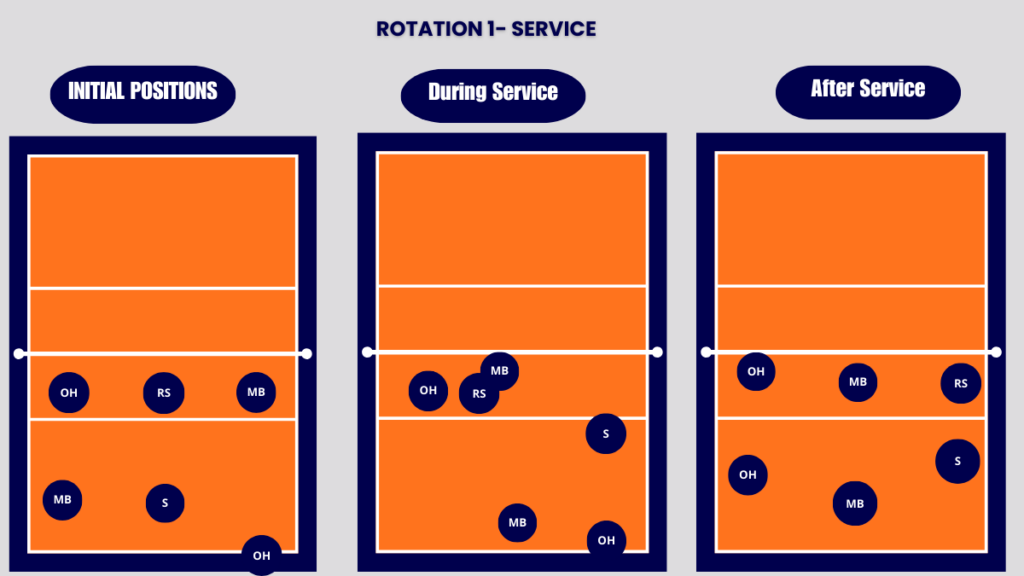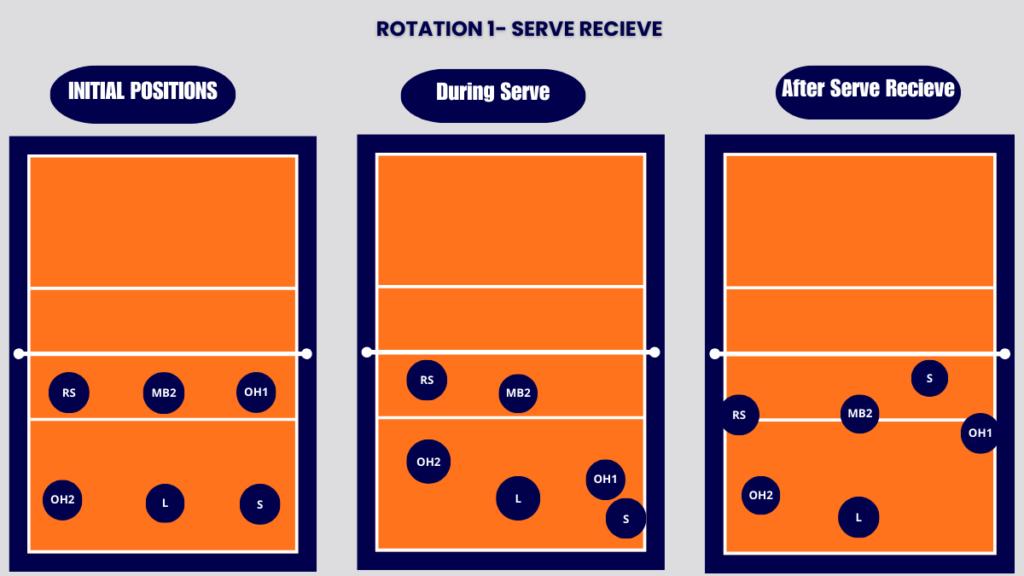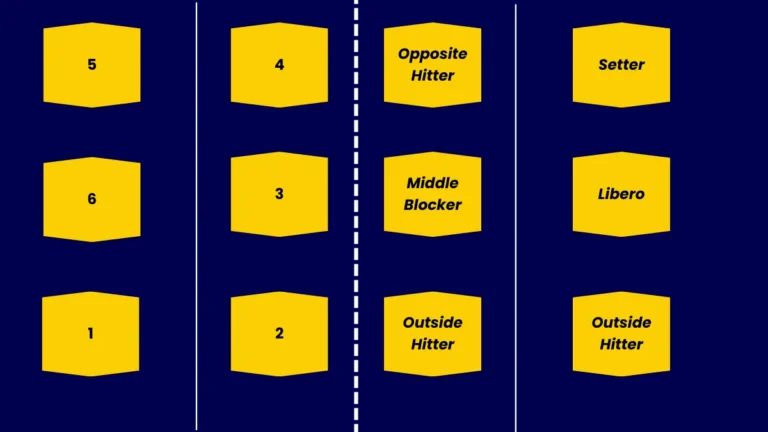Mastering The 6-2 Rotation Strategy in Volleyball

No one can kick you out of the volleyball court if you have the right tricks, techniques, and good formations. Yes, I am saying right! While many factors are important in their own way, one that’s often used is called the 6-2 rotation system.
The 6-2 rotation system is a volleyball formation that uses six hitters and two setters. In this system, there are always three front-row hitters, and the setter is always in the back row. This formation allows for strong offensive options and good defensive coverage.
Here some questions may arise in your mind like What is a 6-2 in volleyball, how to set it up, its benefits, and more. If you want to know all in detail, let’s discuss it.
Understanding Volleyball Formations
Volleyball formations are the backbone of team strategy on the court. These organized player arrangements determine how a team will attack, defend, and transition between plays. Before we start discussing 6-2 system in detail, let’s quickly look at some common volleyball formations:
4-2 Formation
In a 4-2 formation, there are four hitters and two setters. This is a simple system that’s often used by beginner teams.
5-1 Formation
The 5-1 is very popular, especially at higher levels. It uses five hitters and one setter. This formation allows for a consistent setter, which can lead to better offensive plays.
6-2 Formation
The 6-2 is a more complex system that we’ll focus on in this article. It involves all six players on the court taking on different roles as they rotate.
What is a 6-2 in volleyball
The 6-2 rotation strategy is a popular and versatile formation in volleyball that often puzzles newcomers to the sport. By breaking down its components and understanding its flow, you’ll
find it quite simple:
- The “6” refers to the number of hitters in the rotation.
- The “2” refers to the number of setters.
In a 6-2 system, all six players on the court will hit at some point in the rotation. Two of these players will also take turns setting, depending on their position on the court.
Key Features of the 6-2 System
The main characteristics of the 6-2 formation are:
- Three front-row hitters at all times
- The setter is always in the back row
- Two players switch between hitting and setting roles
This setup allows for a strong offensive presence while maintaining defensive coverage.
Player Positions and Tactics in a 6-2 System
In a 6-2 system, each player on the court has specific responsibilities that shift as the game progresses. Understanding these roles is crucial for executing this formation effectively and maximizing its advantages. Here’s a breakdown of the roles:
Setters
The two setters in a 6-2 system play a crucial role:
- When in the back row, they set for the team
- When they rotate to the front row, they become hitters
- This dual role requires setters to be skilled in both setting and hitting
Middle Blockers
Middle blockers play at the net in the center of the court:
- Responsible for blocking the opponent’s attacks
- Perform quick attacks on offense
- Need to be tall, quick, and able to read the game well
Outside Hitters
Outside hitters play on the left side of the court:
- Often receive serves
- Key attackers in the offense
- Should be strong all-around players with good passing and hitting skills
Opposite Hitters
Opposite hitters play on the right side, opposite the setter:
- Need to be strong attackers and blockers
- Often tall players who can hit over blocks
- May need to set if the setter digs the first ball
Libero
While not part of the 6-2 rotation itself, the libero is a defensive specialist:
- Subs in for back row players, usually middle blockers
- Wears a different-colored jersey
- Specialized in passing, digging, and defense
- Cannot serve, block, or attack the ball from above the net height
Remember, in a 6-2 system, players need to be adaptable as their roles can change depending on their position in the rotation.
Rules of 6-2 Rotation
Volleyball rotations have specific rules that players must follow. These rules control how players move and stand on the court during the game.
1. Player Positioning
- Each player’s position is set by the players next to them.
- Players can’t cross certain boundaries before the serve.
- For example, a back-row player can’t move in front of the player directly in front of them.
2. Base Positions
When your team sends the ball to the other side, players should move to their base (or defensive) positions:
- Outside hitters: Front left and back left
- Middle blockers: Middle front and middle back
- Right-side hitter: Front right
- Setters: One in back right, one in front row (acting as hitter)
- Libero or defensive specialist: Middle back
- Other outside hitter: Back left
How to Set Up a Team for 6-2 Rotation
The 6-2 rotation system uses two setters, with one always in the back row. This allows for three hitters in the front row at all times. Here’s how it works:
In a 6-2 system, you only need to learn three main rotations. After these three, the pattern repeats with the other setter.
Rotation #1 – Back Row Setter in Zone 1
- Setter stays back to avoid passing
- Outside hitter moves back to pass
- After serve, setter quickly moves to setting position
- Other players move to hitting positions


Rotation #2 – Back Row Setter in Zone 6
- Setter moves up to the right side
- Middle back shifts to middle for passing
- Outside hitter drops back to pass
- After serve, players move to hitting or setting positions
Rotation #3 – Back Row Setter in Zone 5
- Setter moves up to middle of the court
- Outside hitter moves to passing position
- After serve, players move to hitting or setting positions
Rotations #4, #5, #6 – Repeat with Other Setter
- The setter who was hitting in the front row now becomes the back row setter
- The process repeats for the next three rotations
Key Points to Remember in 6-2 Rotation
- Two setters alternate setting duties.
- The setter in the back row is always the active setter.
- When a setter rotates to the front row, they become a hitter.
- There are always three hitters in the front row.
You may watch the video for practical demonstration
Benefits of Employing a 6-2 Rotation System
The 6-2 system offers several strategic advantages that can give teams an edge on the volleyball court. From increased offensive options to improved defensive coverage, this formation has the potential to elevate a team’s overall performance.
The key benefits that make the 6-2 system a favorite among volleyball strategists!
Offensive Flexibility
With three front-row hitters at all times, the 6-2 system provides many attacking options. This can make it harder for opponents to predict and block attacks.
Balanced Court Coverage
Because the setter is always in the back row, there are always three tall players at the net for blocking. This helps improve the team’s defense against opponent attacks.
Player Versatility
The 6-2 system allows players to develop skills in multiple positions. This can make the team more adaptable and improve overall player development.
Overcoming 6-2 Formation Challenges
While the 6-2 system has many benefits, it also comes with some challenges:
Complexity
The 6-2 is more complex than other formations. Players need to understand multiple roles and be able to switch between them quickly.
Communication
With players changing roles frequently, clear communication is crucial. Teams need to practice their communication to avoid confusion on the court.
Consistency in Setting
Having two setters can sometimes lead to inconsistency in setting style. Setters need to work closely with hitters to develop a consistent rhythm.
Mastering the 6-2 – Tips and Best Practices
While the 6-2 system can be powerful, it requires practice and precision to execute effectively. By focusing on key areas and avoiding common pitfalls, teams can maximize the potential of this versatile formation. To effectively use the 6-2 system, consider these tips:
Training Drills
- Practice quick transitions between roles
- Work on communication drills to improve on-court coordination
- Develop setter-hitter connections for both setters
Communication Strategies
- Use clear, consistent calls for plays and switches
- Encourage players to talk before, during, and after each play
- Assign a court leader to help coordinate positioning
Common Pitfalls to Avoid
- Don’t neglect back row attack practice for setters
- Avoid over-relying on one setter if their setting skills are stronger
- Remember to adjust blocking schemes when the setter is in the front row
Bottom Line
The 6-2 formation in volleyball is a versatile and powerful system that offers teams great offensive flexibility and balanced court coverage. While it requires more complexity and communication than some other formations, mastering the 6-2 can give teams a significant advantage on the court.
By understanding the roles, practicing transitions, and focusing on clear communication, teams can effectively implement this strategy and improve their gameplay.
Frequently Asked Questions
Is the 6-2 formation suitable for beginner teams?
While beginners can learn the 6-2, it’s often better to start with simpler formations like the 4-2 or 6-6.
Can a team switch between 6-2 and other formations during a game?
Yes, teams can switch formations between sets or even during a set, as long as they maintain the correct serving order.
How does the libero fit into a 6-2 system?
The libero is not part of this formation. However, he can substitute for any back row player, including the setter when they’re in the back row.
What are the key skills players need to succeed in a 6-2 formation?
Versatility, strong communication, and the ability to transition quickly between roles are crucial in a 6-2 system.
How does serving work in a 6-2 formation?
The serving order remains constant, but players’ on-court positions will shift to ensure the setter is always in the back row when serving.





